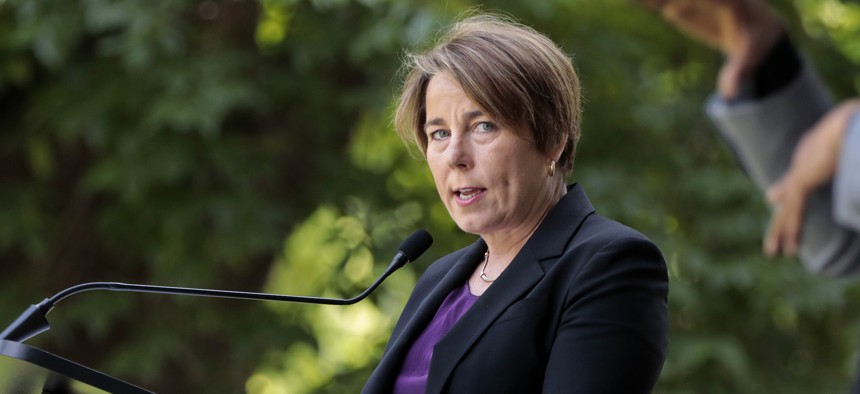A different kind of green bank—one that targets affordable housing

Massachusetts Gov. Maura Healey. Pat Greenhouse/The Boston Globe via Getty Images
Massachusetts launched the nation’s first green bank dedicated to affordable housing.
Between scorching summers and erratic winters, climate change is testing the limits of affordable housing infrastructure in marginalized communities nationwide. Vulnerable populations, including communities of color or low-income communities, are bearing the brunt of these impacts, and are more likely to allocate a larger share of their incomes to energy and housing costs. But a new initiative in Massachusetts is aiming to change that.
Last week, the state launched the Massachusetts Community Climate Bank in an effort to create more climate-friendly, affordable housing. Seeded with $50 million from the state Department of Environmental Protection, officials are hoping the “green bank” will attract private sector capital to retrofit existing buildings and support new construction of sustainable and efficient buildings, according to a release from the governor’s office. The bank will also look to attract federal funds under the Inflation Reduction Act, which includes $27 billion for the Greenhouse Gas Reduction Fund to support clean energy initiatives
While other green banks fund affordable housing initiatives, Massachusetts’ claims its green bank is the first to be entirely dedicated to such efforts. The state will use the capital raised to integrate clean energy and efficient technologies into affordable developments such as solar panels, heat pumps and high-efficiency appliances; create mortgage products for home improvements; and invest in affordable housing decarbonization.
“The Massachusetts Community Climate Bank will be our financial engine for moving forward on our climate goals, relieving the pressure of high housing costs, and creating good jobs and healthier communities,” Gov. Maura Healey said in the press release.
The state is aiming to reduce greenhouse gas emissions from residential heating by 49% by 2030 and 95% by 2050.
By working with MassHousing, the state’s affordable housing finance authority, officials are hoping to leverage existing programs and connections to reach the communities that stand to benefit the most from efficiency upgrades, said Karissa Hand, a spokesperson for the governor’s office.
“We selected MassHousing because it has the financial expertise to hit the ground running, with $6.3 billion in total assets and extensive lending and loan servicing operations,” she said in an email. “Importantly, they have deep relationships with mission-driven housing developers who want, and need, to retrofit their existing portfolios, and they have experience financing deep-energy retrofits.”
Green banks have been around for more than a decade. Connecticut was the first state to adopt a green bank in 2011, and Washington, D.C., became the first city to do so in 2018. But as states and cities look to meet ambitious climate goals, more and more governments are launching green banks to finance essential climate projects.
Green banks typically focus on four categories, according to Reed Hundt, founder and CEO of the Coalition for Green Capital. They are solar development, electric transportation, environmental remediation in buildings and electrification. The banks partner with private lenders to leverage a combination of public and private funds to bolster an oft-neglected market.
For example, retrofitting multifamily homes is a difficult investment proposition, Hundt said. So institutions like green banks will put public money into a project to attract private capital by making the investment a little less risky. That collaboration can look different depending on the project. In some cases, the public sector provides a loan loss reserve, which guarantees payment to the private institution.
Last year, the 40 members of the Coalition for Green Capital, a consortium of state, local and nonprofit green banks nationwide, collectively invested $5 billion, according to Hundt.
“It's not nearly what’s necessary to make the transition from carbon to clean energy for the whole country,” he said. “But it shows that the idea [works].”






